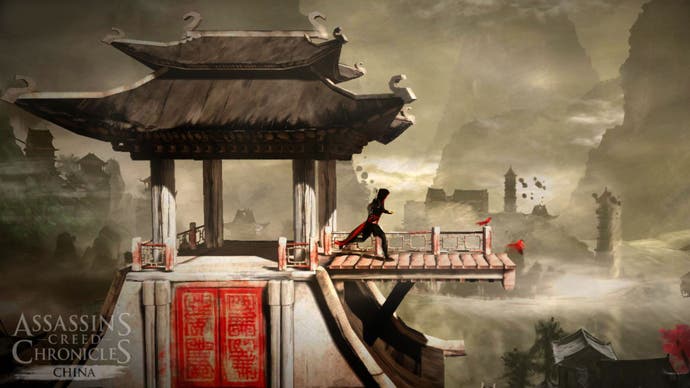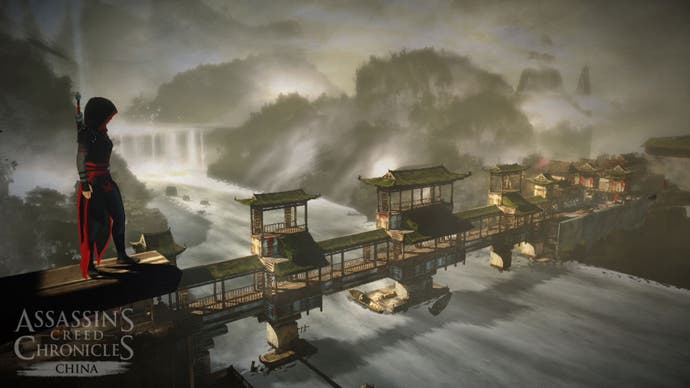Assassin's Creed's move to two dimensions doesn't quite convince
Spar east.
Editor's note: This is an impressions piece on Assassin's Creed Chronicles: China, the first of a three part series. In accordance with our review policy, we'll be posting a full review once all episodes are out.
How do you maintain a sense of cohesion and unity across a video game series that straddles continents, centuries and, in Assassin's Creed Chronicles: China (the first in a new trio of 2.5D, side-scrolling stealth games) even physical dimensions? Developers Climax begins, wisely, for a game of weaponised parkour, with consistency of movement. Your character, Shao Jun, a former concubine of the Emperor Zhengde, has a familiar range of nimble abilities. She can sprint, skulk, wrestle, clamber and dangle (before dropping, knife extended, onto the back of an unsuspecting guard) in much the same way as the other Assassin's Creed stars. No surprise: she was, according to the somewhat implausible backstory, trained by Ezio Auditore, the famous Italian assassin who has fronted the series four times to date.
At the start of the game Jun returns to China, which, in the mid-1500s, is witnessing the collapse of the Ming dynasty. As well as sharing muscle memory with the brotherhood of Ubisoft's assassins, Jun also shares their taste for vendetta. "Until you have experienced the thirst for vengeance, you cannot know the rage it fuels," she says. That vengeance must be meted out on a number of key targets, most of whom loiter at the end of the game's stages. You have no choice over whether to kill or spare these marks, but it's up to you as to whether you take down their plentiful guards en route to the final showdown. There is some room for mercy within this crusade.

While the game accommodates players who wish to engage in open fights with guards (the combat system is well-developed, with blocks, parries, the ability to leap over your opponent's back, perform slide assassinations and even dodge projectiles) its designers encourage a stealth style of play through score weighting. Each stage is broken into numerous set-piece puzzles (e.g. you might need to make it past two roaming guards and a patrol dog) and you are scored on your performance according to whether or not you aroused suspicions or were forced to kill someone. The highest rewards await the silent, non-lethal approach, although you can score a 'gold tier' ranking if you manage to assassinate your opponents without raising suspicion. Perfectionists will find themselves frequently reaching for a restart; it's possible to make a perfect run through the entire game, with an unblemished report card, but doing so will be a long and, often tiresome, challenge.
Each stage is, essentially, a series of sneaking puzzles. You must watch your opponents' routes, wait for their vision cones to part, in order to provide you with a gap through which to sneak. As the game progresses, the number of ways in which you can traverse an area begin to increase - as do the number of potential threats. Later, you'll unlock, for example, the ability to use your rope dart to swing up onto the rafters, while your four main tools offer a (limited) variety of options to distract guards. You can either make a sound to draw their attention to your position with your voice (almost always useless) or use a 'sound dart' to break them out of their usual patrol routes in order to investigate a thrown noise (almost always useful). Firecrackers will instantaneously befuddle a guard for a few seconds, blinding them and making them deaf to sound (although if you bump into a lookout while they're in this bewildered state, they will rouse and engage).
Other potential threats include mooching dogs (that must be stunned or entirely avoided), birds that will raise the suspicious of all nearby guards if you move through their awareness zone quickly and wind chimes, under which you must crawl. The environment can be used to your advantage too, as you duck into shady doorways, flit between pillars or disappear into small crowds of passers-by. Climax finds a use for most of the traditional Assassin's Creed furniture. You often work your way to a high point ledge in a stage, where you are able to 'synch', which automatically add points of interest to your map, before leaping off and landing in a cart of hay far below (this admittedly lacks some of the vertigo inducing appeal found in the 3D cousins...) while glowing 'animus shards' provide collectibles, plopped in far flung corners of the map. While the game's posture is one of revenge and violence, there are some more magnanimous activities to be found in the secondary objectives, which encourage you to find and free slaves, or light candles for your fallen comrades.
The game's depiction of China is handsome and painterly, as if the concept art has been imported wholesale into the playable scenes. The watercolour swirls and smudges may have been added in Photoshop, but the effect is no less striking, and gives each locale, from the Majishan Grottoes (a series of dimly lit caves inside the Majishan mountain) to the Port of Macau (a provincial port in Southern with its misty mountains and firework displays of cherry blossom), a vivid style.

Environments aren't always the most clearly navigable so the game's artists use crimson smears to indicate interactive objects and pathways: poles, planks and ladders, liberally garnished with blood to lead you through each stage. The bold art style of the backgrounds extends to the effects of your actions (in particular, the Pollock-esque flecks of on-screen blood that accompany each thrust and swipe of your weapon through flesh) but the characters themselves have a more lacklustre and customary styling. For a game so focused on the art of parkour, Jun's transitions between surfaces can be clunky and jittering.
Moreover, the stop start nature of the action, forced by the succession of puzzles, sits at odds to Jun's free-running spirit and ability. The stealth imposes an awkward rhythm on a character expressly designed to flit and fly through the world. The tension is most plainly revealed in one later stage where you have to flee a burning city against the clock. Untethered from the stealth and puzzling, there's a freedom and joy to traversing the environment that is missing elsewhere. It reveals what might prove a troublesome truth for this miniseries: Assassin's Creed's traversal from the third dimension to the second appears to be one best made at speed, without too much pause for thought.


